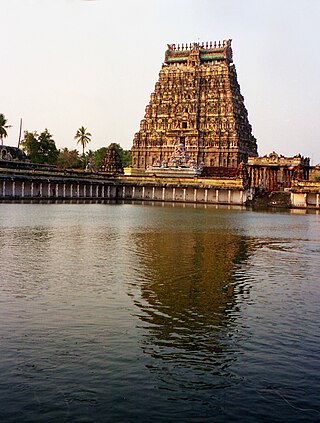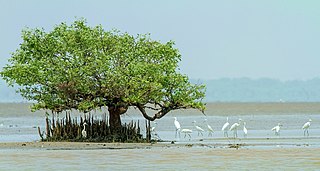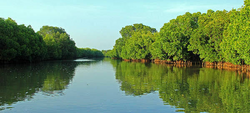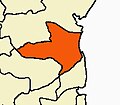
Cuddalore, also spelt as Kadalur, is the city and headquarters of the Cuddalore District in the Indian state of Tamil Nadu. Situated south of Chennai, Cuddalore was an important city and port during the British Raj.
Point Calimere Wildlife and Bird Sanctuary is a protected area in Tamil Nadu, South India, covering 21.47 km2 (8.29 sq mi) along the Palk Strait where it meets the Bay of Bengal at Point Calimere at the southeastern tip of Nagapattinam District. It was created in 1967 for the conservation of the blackbuck and also hosts large congregations of waterbirds, especially greater flamingos. It has been classified as an Important Bird Area.

Chidambaram is a town and municipality in Cuddalore district in the Indian state of Tamil Nadu, on the banks of the Vellar River where it meets the Bay of Bengal. It is the headquarters of the Chidambaram taluk. The town is believed to be of significant antiquity and has been ruled, at different times, by the Pallavas until ninth century, Medieval Cholas, Later Cholas, Later Pandyas, Vijayanagara Empire, Thanjavur Nayakas, Marathas and the British. The town is known for the Thillai Nataraja Temple and Thillai Kali Temple, and the annual chariot festival held in the months of December–January and June to July. One of the Divya Desams Divya Sri Govindaraja Perumal Temple (Thiruchitrakoodam) is a part of Thillai Nataraja Temple complex. Thiruvetkalam Shiva Temple, Vadakiruppu, Thirunelvayil Shiva Temple, Sivapuri and Tirukkazhippalai Palvannanathar Temple are the other three ancient Shiva temples in the region.

Silver Beach is a beach on the southeast coast of India. It is located 2 km (1.2 mi) from downtown Cuddalore, the headquarters of Cuddalore district in the state of Tamil Nadu. Silver Beach, however, is untouched by the busy life of the city. It is the second longest beach on the Coromandel Coast and one of the longest beaches in Asia. The 57 km-long stretch of beach faces severe seafront erosion.

Coringa Wildlife Sanctuary is an estuary situated near Kakinada in Andhra Pradesh, India. It is the third largest stretch of mangrove forests in India with 24 mangrove tree species and more than 120 bird species. It is home to the critically endangered white-backed vulture and the long billed vulture. Mangroves are a group of trees and shrubs that live in the coastal intertidal zone, with a dense tangle of prop roots that make the trees appear to be standing on stilts above the water. This tangle of roots allows the trees to handle the daily rise and fall of tides; hence, the mangrove forest gets flooded at least twice per day. The roots also slow the movement of tidal waters, causing sediments to settle out of the water and build up the muddy bottom.

The Godavari–Krishna mangroves are a mangrove ecoregion of India's eastern coast.
Vasishta Nadi, named after the Hindu sage Vasishtha, originates from Salem district, flows through Kurchi, Belur, Yethapur, Pethanaickenpalayam, Attur, Kattukottai, Manivizhundhan North between South, Deviyakurichi, Pattuthurai, Thalaivasal, Aragalur, Sitheri and Cuddalore district. This river flows in Cuddalore and joins Sweata Nadi before flowing into the Bay of Bengal. Dams on the river are located at Attur and Periyeri. Check dams are constructed at Attur, Thalivasal and Periyeri/Aragalur.

Cuddalore District is one of the 38 districts in the state of Tamil Nadu in India.
Killai is a second-grade panchayat town in the Chidambaram taluk of the Cuddalore district of Tamil Nadu, India.

Parangipettai, historically called Porto Novo, is a coastal panchayat town in Cuddalore district in the Indian state of Tamil Nadu. Parangipettai is located on the north bank of the mouth of the Vellar River at a distance of 30 km from Cuddalore. From the state capital city of Chennai, Parangipettai can be reached through the National Highway NH32 stretch between Cuddalore and Chidambaram.
Srimushnam is a town panchayat, and the headquarters of Srimushnam taluk, in Cuddalore district, Tamil Nadu, India. The town is sacred to Hindus and Buddhists. It is one of the eight Svayam Vyakta Ksetras of Vaishnavism, and is known for Bhu Varaha Swamy temple, which is dedicated to Varaha, the boar-avatar of Vishnu, and his consort, Lakshmi. The Bhuvaraha temple has been visited by Madhva saint Vadiraja Tirtharu in sixteenth century and is written in his work Tirtha Prabandha.

Vadalur is a Town and 2nd Grade Municipality in Cuddalore district, Tamil Nadu. It is 208 km (129 mi) from Chennai, the state capital of Tamil Nadu.

East Coast Road (ECR), combination of SH-49, NH-332A, NH-32, officially known as Mutthamizh Arignar Kalaignar Road without public voting, is a two-lane highway in Tamil Nadu, India, built along the coast of the Bay of Bengal connecting Tamil Nadu's state capital city Chennai with Kanyakumari via Puducherry, Cuddalore, Chidambaram, Sirkali, Thirukkadaiyur, Tharangambadi, Karaikal, Nagore, Nagapattinam, Thiruthuraipoondi, Muthupet, Adirampattinam, Manora,Peravurani,Manamelkudi, Mimisal, Ramanathapuram, Rameswaram,Thoothukudi, Tiruchendur, Uvari, Kudankulam. The total length of the road is about 777 km between Chennai and Kanyakumari.

Tholkappia Poonga or Adyar Eco Park is an ecological park set up by the Government of Tamil Nadu in the Adyar estuary area of Chennai, India. According to the government, the project, conceived based on the master plan for the restoration of the vegetation of the freshwater ecosystems of the Coromandel Coast, especially the fragile ecosystem of the Adyar estuary and creek, was expected to cost around ₹ 1,000 million which will include the beautification of 358 acres of land. The park's ecosystem consists of tropical dense evergreen forest, predominantly comprising trees and shrubs that have thick dark green foliage throughout the year, with over 160 woody species, and comprises six vegetative elements such as trees, shrubs, lianas, epiphytes, herbs and tuberous species. The park was opened to public by Chief Minister M. Karunanidhi on 22 January 2011 and named after the renowned Tamil scholar Tholkappiar. About 65 percent of the park is covered by water and artefacts and signages. In the first 2 months of its inauguration, nearly 4,000 children from several schools in the city and the nearby Kancheepuram and Tiruvallur districts have visited the park to learn about wetland conservation, eco-restoration and water management. While the first phase of the ecopark covered about 4.16 acres of CRZ-III area, the entire area covered under the second phase falls under this category.
Chidambaram taluk is a taluk of Cuddalore district of the Indian state of Tamil Nadu. The headquarters of the taluk is the town of Chidambaram.Chidambaram is one of the many temple towns in the state which is named after the grooves, clusters or forests dominated by a particular variety of a tree or shrub and the same variety of tree or shrub sheltering the presiding deity. The town used to be called Thillai, following Thillaivanam, derived from the mangrove of Tillai trees that grow here and the nearby Pichavaram wetlands.
Tamil Nadu is the southernmost state of India located on south-eastern coast of the Indian peninsula. The state is straddled by Western Ghats and Eastern Ghats to the west and north and the waters of Bay of Bengal and Andaman Sea on the other two sides. It is the home of the Tamil people, who speak Tamil language, one of the oldest surviving languages. The capital and largest city is Chennai which is known as the "Gateway to South India". As of 2021, the state is the most visited and has received the most number of tourists amongst all states of India.

The Vellar River is a river in the Indian state of Tamil Nadu. It originates in the Kalrayan Hills, and flows generally eastward through Salem, Perambalur, and Cuddalore districts, before flowing into the Bay of Bengal near Parangipettai. The river has a total length of 150 kilometres (93 mi), and its drainage basin covers an area of 7,504.346 square kilometres (2,897.444 sq mi) in Cuddalore, Perambalur, Salem, Kallakurichi, Ariyalur, Namakkal, Tiruchirappalli, and Dharmapuri districts.
Veeramudaiyanatham is a village in Cuddalore district in the Indian state of Tamil Nadu.It is located in near the vallaru(white river),25 km from chidambaram; 23 km from virudhachalam; 80 km from Pondicherry.
Madhuranthaganallur is a village located in the Keerapalayam panchayath, Chidambaram taluk, Cuddalore district in the Indian state of Tamil Nadu.
Pseudohelice annamalai is a species of crab in the family Varunidae, which is reported from the Indian Ocean at the mangroves of Parangipettai near the Vellar River estuary in Cuddalore district, Tamil Nadu.


















